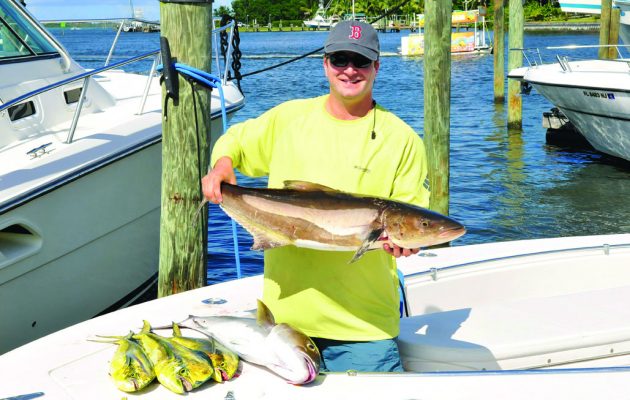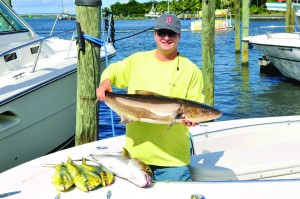Tips for fishing the finicky cobia

By Nathan & Ted Miller
With the vernal equinox, the month of March marks the beginning of spring. Days will become longer and sea surface temperatures will begin to increase as we move away from the colder winter months.
March offers great offshore action as pelagic species migrate along the edge of the Gulf Stream. But March also offers great action closer to home.
When March arrives, it is time to go look for cobia.
Cobia will begin to move in from the offshore reefs and wrecks and migrate northward up the coast of Florida following the bait pods when the water temperature along the coast reaches around 68 degrees.
The sea temperature is very important to know. Inlets to our north (St. Marys River) will tend to hold colder temperatures a bit longer (mid 60s) making the decision to fish out of Mayport – or south to St. Augustine, Matanzas or even further south to warmer temperatures – a good call. As the weeks pass, the warmer water will make its way north allowing all the inlets at some point to produce fish this time of year.
As sea temperatures rise, large schools of bait (pogies) will begin to show up. These large pods can be in a wide range of depths. They can be found just outside the breakers in 15 feet of water, or two to three miles offshore in 45 to 55 feet. If you hear reports that bait is showing up but not sure exactly where, a good method is to run north or south (depending on where the best sea temperature is) in zigzag patterns ranging in depths of 15 to 55 feet until you find the bait.
While you are running in search of bait, always be on the lookout. Cobia can be found free-swimming along the surface either by themselves or with others.
When you spot one, your first instinct may be that you are looking at a shark. Their large brown bodies with flattened heads have fooled many anglers. With a closer look you will see their lower protruded jaw and large-fan tail gives away their identity.
Cobia can be very curious. With a motor in neutral or turned off, you may find that cobia will come along boat side just below the surface to check you out. This is a perfect time to introduce your bait. Cobia can be extremely finicky and often times will play around with your bait without consuming, or may even swim off without showing any interest. This can be very frustrating for any angler.
Anglers who have spent some time chasing cobia have tried different presentations and baits. Artificial eel tails on jigs, lures, live bait such as pilchards, catfish, crabs and even live eels have all been used. They can all be very effective, but can all strike out just as easily. I have found whatever bait you prefer, cobia like a challenge. Moving your bait close to the fish until it is seen or the scent is picked up and then allowing your bait to fall toward the bottom can be just enough of a challenge for your bait to be chased. If you are fishing 8” to 10” eel tails, allow the bait to be consumed for a few seconds. Many anglers have pulled these baits from the mouth of a cobia as the hook never made it to the jaw.
If you miss the first strike, don’t give up. Their curiosity will often times entice them to come back and strike again.
Cobia found swimming around bait pods can be very unpredictable. They can be seen just below the surface circling the pods slowly. Or they may sit motionless on top of the pod. In either case, presenting baits will produce different results. Either they will act disinterested and slowly swim off. Or they will jump on and consume whatever you throw at them. If it is the latter, you are in for a real fight.
They can also be targeted around many different types of structures. It is always good practice to check buoys and other floating debris you see. Cobia will also tag along with other sea creatures like sea turtles, sharks or manta rays in hopes of picking up an easy meal left behind.
Fishing for cobia is a lot like stalking. And because fish can be hooked in close proximity to the boat, often times the fish are brought along boat side within seconds of the hook set before they really know they are hooked. This is no time to bring a fish on board unless you have a large fish box open and ready to receive your prize, and another angler ready to slam the fish box door closed. Cobia can act very lethargic in the water. But when boated too soon, they can do as much damage to gear as any fish. Their large tails and broad bodies can be impossible to control and is best to wear them down before bringing on board.
In my opinion, cobia is some of the best fish to eat. The white flaky meat is easy to cook and does not dry out on the grill like other table-fare fish can.
Because visibility is so important in finding these fish, it is best to wait until the sun is at its highest to eliminate as much glare on the surface as possible. A good pair of polarized and UV protected sunglasses is also good to have.
For visibility, I have found the best time to be on the water is from around 10:30 a.m. until around 3 p.m. This mid-day fishing makes it easy and enjoyable for everyone.
And who knows? Maybe there will be fresh cobia for dinner.







